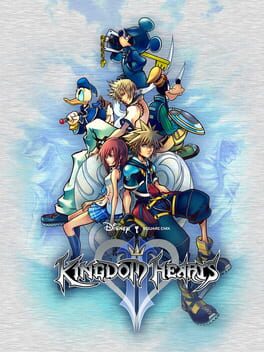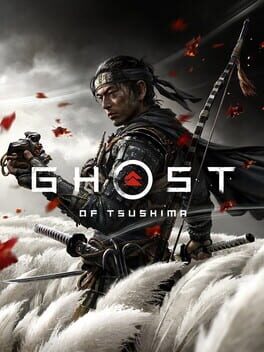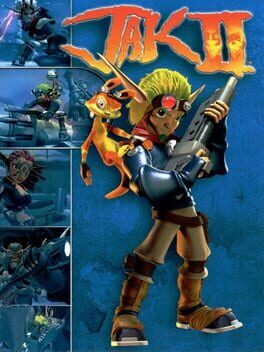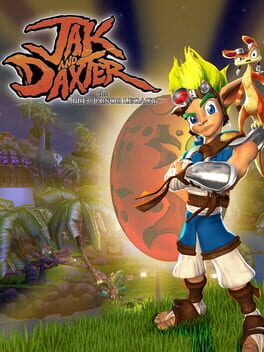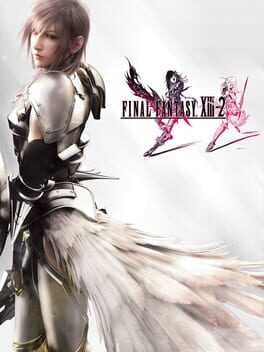SakiSakiSakiSaki
Bio
Active PlayStation trophy hunter since 2011.
PSNProfile: https://psnprofiles.com/SakiSakiSukiSuki
Active PlayStation trophy hunter since 2011.
PSNProfile: https://psnprofiles.com/SakiSakiSukiSuki
Badges

N00b
Played 100+ games
Favorite Games
169
Total Games Played
001
Played in 2024
000
Games Backloggd
Recently Played See More
Recently Reviewed See More
Prior to getting a PS3, one of the games I grew on were the Jak and Daxter games. They were an integral part of my childhood, as they shown me what the evolution of world building could lead to. I would eventually pick the PS3 remasters up to work towards their platinum trophies.
Jak II was a special game for me growing up, one could call it “baby’s first GTA”. The jarring change from the first Jak game to Jak II is something that still makes me scratch my head to this very day. Gone are the platformer centric tropical levels, in its place is a dank cyberpunk-esque city under totalitarian rule.
Jak’s melee combat and mobility are largely carried over unchanged, with certain levels still maintaining some platformer design elements. Replacing the four Eco powers are four guns with varied bullet distance and rate of fire; in simple terms you have your shotgun, machine gun, sub-machine gun, and missile launcher. Jak also has an “awakened form” of sorts, titled Dark Jak. This form increases his speed, melee damage, and unlocks some area of effect finishers. Jak’s abilities and toolset progresses through new weapons, weapon damage increases, Dark Jak abilities, and minor modes of transportation.
Speaking of transportation, the primary method of getting around are hovering vehicles. They’re essentially cars that can hover 2 to 8 feet off the ground. You acquire these by carjacking a driver GTA-style or taking a vacated one. Due to the structure of the series shifting to a more hub-oriented layout, the player would have to travel much greater distances to reach objectives.
Some traces of the first game’s collectahon DNA can be found in Jak II; the previously common Precursor Orbs are much rarer to find in here. These orbs can be used to unlock “Secrets” which effectively serve as cheat codes like infinite health, ammo, and skins. There’s a trophy on the PS3 that involves collecting all the Precursor Orbs. I couldn’t arsed to do all that, so I just performed a glitch that involves jumping above an orb and restarting the checkpoint. Infinite orbs!
The setting is quite interesting if not a done to death. The sequel begins with Jak and company getting teleported into the far flung future, with Jak separated from the rest and imprisoned as a lab rat for two years. Aside from gameplay, the most jarring change of Jak II would be the change to Jak’s character. Gone is the young mute boy, in his place is an “edgier” vengeful adult with a goatee. In hindsight, Naughty Dog most likely had some doubts on whether this change would be accepted by the fans of the first game. Some familiar characters do return, such as Keira, the Green Sage, and of course Daxter. But a mass majority of the cast are natives of the future. The new cast was ultimately a boon as the previous game’s villagers were nothing more than background civilians with no relevance to the plot. This game has dictators, soldiers, lieutenants, racing, conspiracies, betrayals, a prophetic doomsday, and an interesting plot twist.
Overall Rating: 92
Jak II was a special game for me growing up, one could call it “baby’s first GTA”. The jarring change from the first Jak game to Jak II is something that still makes me scratch my head to this very day. Gone are the platformer centric tropical levels, in its place is a dank cyberpunk-esque city under totalitarian rule.
Jak’s melee combat and mobility are largely carried over unchanged, with certain levels still maintaining some platformer design elements. Replacing the four Eco powers are four guns with varied bullet distance and rate of fire; in simple terms you have your shotgun, machine gun, sub-machine gun, and missile launcher. Jak also has an “awakened form” of sorts, titled Dark Jak. This form increases his speed, melee damage, and unlocks some area of effect finishers. Jak’s abilities and toolset progresses through new weapons, weapon damage increases, Dark Jak abilities, and minor modes of transportation.
Speaking of transportation, the primary method of getting around are hovering vehicles. They’re essentially cars that can hover 2 to 8 feet off the ground. You acquire these by carjacking a driver GTA-style or taking a vacated one. Due to the structure of the series shifting to a more hub-oriented layout, the player would have to travel much greater distances to reach objectives.
Some traces of the first game’s collectahon DNA can be found in Jak II; the previously common Precursor Orbs are much rarer to find in here. These orbs can be used to unlock “Secrets” which effectively serve as cheat codes like infinite health, ammo, and skins. There’s a trophy on the PS3 that involves collecting all the Precursor Orbs. I couldn’t arsed to do all that, so I just performed a glitch that involves jumping above an orb and restarting the checkpoint. Infinite orbs!
The setting is quite interesting if not a done to death. The sequel begins with Jak and company getting teleported into the far flung future, with Jak separated from the rest and imprisoned as a lab rat for two years. Aside from gameplay, the most jarring change of Jak II would be the change to Jak’s character. Gone is the young mute boy, in his place is an “edgier” vengeful adult with a goatee. In hindsight, Naughty Dog most likely had some doubts on whether this change would be accepted by the fans of the first game. Some familiar characters do return, such as Keira, the Green Sage, and of course Daxter. But a mass majority of the cast are natives of the future. The new cast was ultimately a boon as the previous game’s villagers were nothing more than background civilians with no relevance to the plot. This game has dictators, soldiers, lieutenants, racing, conspiracies, betrayals, a prophetic doomsday, and an interesting plot twist.
Overall Rating: 92
This review contains spoilers
Prior to getting a PS3, one of the games I grew on were the Jak and Daxter games. They were an integral part of my childhood, as they shown me what the evolution of world building could lead to. I would eventually pick the PS3 remasters up to work towards their platinum trophies.
The first Jak game is essentially a generic collectathon of its time. Every region has sets of items you can collect, such as “Precursor Orbs” that serve as the game’s currency, and “Power Cells” as the main collectible that would progress the story.
The gameplay is nothing to write home about. Jak has a varied set of melee attacks and mobility, allowing cross large gaps. He can also empower himself with the power of “Eco”, this colored substance that will give him a temporary ability depending on it’s color. One of the side objectives of this game is to open up these “Eco vents” across all the levels, to unlock passage ways or to reach a collectible. You’ll occasionally pass by a closed vent, reminding you to return to that area once you have the corresponding Eco color’s vent open. The platforming was fine, although the air bike segments did cause some frustration due to its poor control.
The initial setting did fill me with some warmth the first time I played it; a young boy from a quaint village by the waters getting into shenanigans with his friend-turned-rodent. Dark eco established itself as a toxic and powerful substance, capable of mutating things in unpredictable ways.
The village itself was entertaining on its own. Many of the villagers can offer interesting dialogue or a side quest that rewards a key collectible. The characters are all varied with bold personalities. Kiara and the Green Sage in particular were excellent support characters to Jak and Daxter, supporting them in their quest to turn Daxter back into a human. I remember having a crush on Kiara as a kid, in a way I imagine many teenagers with Tifa from Final Fantasy 7.
The two villains provided excellent lore, but were poorly written and largely shelved for a large part of the story. Their citadel was interesting for a final challenge; the different usages of Eco and the tight platforming challenged everything the player had learned up to that point.
The final boss wasn’t as enjoyable as the rest of the game, from a thematic and mechanical perspective. The game was quite fun, and did a lot with so little.
Overall Rating: 65
The first Jak game is essentially a generic collectathon of its time. Every region has sets of items you can collect, such as “Precursor Orbs” that serve as the game’s currency, and “Power Cells” as the main collectible that would progress the story.
The gameplay is nothing to write home about. Jak has a varied set of melee attacks and mobility, allowing cross large gaps. He can also empower himself with the power of “Eco”, this colored substance that will give him a temporary ability depending on it’s color. One of the side objectives of this game is to open up these “Eco vents” across all the levels, to unlock passage ways or to reach a collectible. You’ll occasionally pass by a closed vent, reminding you to return to that area once you have the corresponding Eco color’s vent open. The platforming was fine, although the air bike segments did cause some frustration due to its poor control.
The initial setting did fill me with some warmth the first time I played it; a young boy from a quaint village by the waters getting into shenanigans with his friend-turned-rodent. Dark eco established itself as a toxic and powerful substance, capable of mutating things in unpredictable ways.
The village itself was entertaining on its own. Many of the villagers can offer interesting dialogue or a side quest that rewards a key collectible. The characters are all varied with bold personalities. Kiara and the Green Sage in particular were excellent support characters to Jak and Daxter, supporting them in their quest to turn Daxter back into a human. I remember having a crush on Kiara as a kid, in a way I imagine many teenagers with Tifa from Final Fantasy 7.
The two villains provided excellent lore, but were poorly written and largely shelved for a large part of the story. Their citadel was interesting for a final challenge; the different usages of Eco and the tight platforming challenged everything the player had learned up to that point.
The final boss wasn’t as enjoyable as the rest of the game, from a thematic and mechanical perspective. The game was quite fun, and did a lot with so little.
Overall Rating: 65
I remember jumping on this game right after platinuming FF13, thinking it would be more or less the same. It was hard imagining what a sequel could look like, given how final the ending was for Lightning and friends. I suppose too much was invested into the world building, lore, and canonical history to not explore further.
Taking place immediately after the first game, you play as Lightning’s sister, Serah, on her journey to find Lightning who has gone missing. Fal'Cie, L'Cie and Cie'th are all still around and just as confusing as the first game, although they play a much smaller role in this entry. The similarties between both entries are apparent right as you boot the title screen; everything that was green is now pink, everything that was thin is now bold. One thing I found to be unfortunate is how FF13-2 did not share the same crystalline tone and aesthetic that the first game had. Everything is bolder, fatter, and quicker paced; gone are the sleek menus with animated character portraits. While the game has its own unique appeal with the addition of rock battle OST and faster animations, it’s too unlike the first game for my liking. I guess it’s a matter of expectation.
While Noel's design felt fresh and reminscent of prior Final Fantasy games, the remaining cast felt sparse and unmemorable. Caius on the otherhand, was the perfect villain for a game like ths. It's no surprise that his silhouette is featured on the game's logo; his dark purple appearance strikingly compliments Lightning's softer pink design. Giving the adversary a face, a name, and a goal makes the entire journey feel that much more cohesive.
One of the core gameplay changes would be the removal of a third permanent party member. For the entire game, the only two party members you’ll play as are Serah and Noel (excluding guest characters). The third party member will be a monster that you’re able to recruit during battle. The upside to this is that it diversifies the amount of skills and attacks you can have in your party. The downside is that you’re less likely to get attached to the cast due to its tiny size. Every cutscene and story beat will primarily star Serah and Noel.
The way FF13-2 addressed the first game’s criticism of being too linear was to allow the you to teleport to previous areas, and also allowing you to visit alternate versions of areas that take place in parallel timelines. A neat idea, but given that each alternate area felt far too similar to the original area, it really just felt like you had a handful of areas that you were cycling between.
The vibes of the first game aren't entirely here, going more for a J-Pop ""pink"" aesthetic with Serah's costume mimicking an idol's dress. There is also a less foreboding tone overall, with the lack of a countdown on the character's mortalities. The difficulty was about on par as the first the game, without the massive weapons grind. The platinum trophy also posed very little challenge aside from finishing all the side-quests and hunting down all monsters. An upgrade from FF13 in some ways, and a downgrade in others.
Overall Rating: 80
Personal Difficulty: 40
Trophy Hunting Difficulty: 45
Taking place immediately after the first game, you play as Lightning’s sister, Serah, on her journey to find Lightning who has gone missing. Fal'Cie, L'Cie and Cie'th are all still around and just as confusing as the first game, although they play a much smaller role in this entry. The similarties between both entries are apparent right as you boot the title screen; everything that was green is now pink, everything that was thin is now bold. One thing I found to be unfortunate is how FF13-2 did not share the same crystalline tone and aesthetic that the first game had. Everything is bolder, fatter, and quicker paced; gone are the sleek menus with animated character portraits. While the game has its own unique appeal with the addition of rock battle OST and faster animations, it’s too unlike the first game for my liking. I guess it’s a matter of expectation.
While Noel's design felt fresh and reminscent of prior Final Fantasy games, the remaining cast felt sparse and unmemorable. Caius on the otherhand, was the perfect villain for a game like ths. It's no surprise that his silhouette is featured on the game's logo; his dark purple appearance strikingly compliments Lightning's softer pink design. Giving the adversary a face, a name, and a goal makes the entire journey feel that much more cohesive.
One of the core gameplay changes would be the removal of a third permanent party member. For the entire game, the only two party members you’ll play as are Serah and Noel (excluding guest characters). The third party member will be a monster that you’re able to recruit during battle. The upside to this is that it diversifies the amount of skills and attacks you can have in your party. The downside is that you’re less likely to get attached to the cast due to its tiny size. Every cutscene and story beat will primarily star Serah and Noel.
The way FF13-2 addressed the first game’s criticism of being too linear was to allow the you to teleport to previous areas, and also allowing you to visit alternate versions of areas that take place in parallel timelines. A neat idea, but given that each alternate area felt far too similar to the original area, it really just felt like you had a handful of areas that you were cycling between.
The vibes of the first game aren't entirely here, going more for a J-Pop ""pink"" aesthetic with Serah's costume mimicking an idol's dress. There is also a less foreboding tone overall, with the lack of a countdown on the character's mortalities. The difficulty was about on par as the first the game, without the massive weapons grind. The platinum trophy also posed very little challenge aside from finishing all the side-quests and hunting down all monsters. An upgrade from FF13 in some ways, and a downgrade in others.
Overall Rating: 80
Personal Difficulty: 40
Trophy Hunting Difficulty: 45
